An Exploratory Investigation of Implementation of Building Information Modeling in Nepalese Architecture–Engineering–Construction Industry
Abstract
1. Background
2. Introduction
- (1)
- Visualization: The in-house rendering function of the BIM software can easily generate the required 3D visualization. The model-based/3D information is easy to interpret, and the focus of stakeholder discussion can be tailored toward creative solutions.
- (2)
- Fabrication/shop drawings: The coordinated drawings with all the respective building systems can be generated once the BIM models of the involved disciplines have been finalized [42].
- (3)
- Integrated project delivery (IPD) and code reviews: The BIM models could be used for performing reviews of the building projects by the fire department and other officials. Paired with IPD, the risks and rewards are shared and there is increased trust between stakeholders [43].
- (4)
- Forensic analysis: Illustration of potential failures, leaks, evacuation plans, etc., can be graphically achieved utilizing the building information models [38].
- (5)
- Facilities management: Retrofitting, renovations, space planning, energy evaluations, and maintenance operations can utilize BIM in the facilities management phase by the respective infrastructure department [44].
- (6)
- Cost estimating: Cost and material quantity can be estimated in the BIM software as most software choices consist of built-in functions for these purposes [45].
- (7)
- Construction sequencing and clash detection: 4D BIM can be performed for extracting schedules, bills of quantities, and fabrication. Interference checking can be executed visually in the scaled 3D environment for verifying intersections, clashes, and conflicts with the various building systems [46].
2.1. Benefits of BIM in the AEC Industry
2.1.1. Benefits of 3D BIM
2.1.2. Benefits of 4D BIM
2.1.3. Benefits of 5D BIM
2.2. BIM Adoption and Its Challenges
3. Methodology
- ○
- The first section gathered the demographic information of the respondents.
- ○
- The second section assessed professional BIM experience drawn from the items of years of experience, type of company, respondents’ discipline, role, educational qualification, project delivery method familiarity, CAD experience, and BIM familiarity.
- ○
- The third section grouped the items related to BIM implementation status, including BIM proficiency level, BIM-based workflow, BIM tools and services, BIM cost, and the effect of BIM on project performance.
- ○
- In the fourth section, respondents were asked to select drivers and barriers, and also provided options to evaluate BIM benefits on a 5-point Likert-type scale (1 = low intensity, 5 = high intensity).
- ○
- The final section was intended to provide participants an opportunity to give their opinion and recommendations regarding BIM in future projects.
4. Analysis and Results
4.1. Inter-Rater Reliability
4.2. BIM Implementation Status in Nepal
- (a)
- Participant’s role in industry
- (b) BIM components in the design process
- (c) Definition of BIM
- (d) BIM Software and Services
4.3. Barriers to BIM Implementation
4.4. Regression Model between Future BIM Use and BIM Benefits
| Variable | Description |
| amdl | Architectural BIM, independent variable (IV) |
| smdl | Structural BIM |
| mepl | MEP/HVAC BIM |
| cost | BIM-based cost calculation |
| qtoc | BIM-based quantity calculation |
| sche | BIM-based scheduling |
| clas | Clash detection |
| drev | Improving design review |
| docm | BIM-based documentation |
| nexp | BIM use in next project = yes, no, or maybe—target variable |
| Estimate | Std. Error | z Value | Pr (>|z|) | |
| (Intercept) | 0.595 | 0.8613 | 0.691 | 0.489675 |
| amdl | 0.5578 | 0.5331 | 1.047 | 0.295329 |
| smdl | 1.3178 | 0.8397 | 1.569 | 0.116577 |
| mepl | −3.0562 | 0.8096 | −3.775 | 0.000160 *** |
| cost | −3.5853 | 1.3046 | −2.748 | 0.005990 ** |
| qtoc | 1.6418 | 0.7931 | 2.07 | 0.038457 * |
| sche | 1.9211 | 0.8897 | 2.159 | 0.030835 * |
| class | −5.1517 | 1.3478 | −3.822 | 0.000132 *** |
| drev | 1.8309 | 1.115 | 1.642 | 0.100567 |
| docm | 4.4725 | 1.0577 | 4.228 | 0.0000235 *** |
4.5. Suggestions Provided by the Participants
5. Conclusions
- i.
- Government introduction of BIM policy, guidelines, and standards of practice.
- ii.
- Provide training and mentorship programs for practicing engineers and architects.
- iii.
- Provide technical assistance program for universities to incorporate a BIM-related curriculum.
- iv.
- Review national procurement acts to incorporate BIM-based project delivery.
- v.
- Educate and mandate private sector clients to have BIM as required deliverables.
- vi.
- Start discourse on the legal barriers to the implementation of BIM.
- vii.
- Municipalities can require a 3D model to obtain a construction permit.
- viii.
- Develop a coherent ecosystem of information management in design, construction, and operation to enhance model reliability.
- ix.
- The government can give tax incentives to firms that push for digital project management.
- x.
- Make BIM learning a part of the licensure exam/renewal for architects and engineers so they remain up to date with current trends in the AEC industry.
Author Contributions
Funding
Data Availability Statement
Acknowledgments
Conflicts of Interest
References
- Demian, P.; Walters, D. The Advantages of Information Management through Building Information Modelling. Constr. Manag. Econ. Taylor Francis J. 2014, 32, 1153–1163. [Google Scholar] [CrossRef]
- Hatami, M.; Paneru, S.; Flood, I. Applicability of Artificial Intelligence (AI) Methods to Construction Manufacturing: A Literature Review. In Construction Research Congress 2022; American Society of Civil Engineers: Reston, VI, USA, 2022; pp. 1298–1306. [Google Scholar] [CrossRef]
- Dixit, S.; Mandal, S.N.; Thanikal, J.V.; Saurabh, K. Evolution of Studies in Construction Productivity: A Systematic Literature Review (2006–2017). Ain Shams Eng. J. 2019, 10, 555–564. [Google Scholar] [CrossRef]
- Saka, A.B.; Chan, D.W.M.; Siu, F.M.F. Adoption of Building Information Modelling in Small and Medium-Sized Enterprises in Developing Countries: A System Dynamics Approach. In Proceedings of the CIB World Building Congress, Hong Kong, China, 17–21 June 2019; 15. [Google Scholar]
- Matarneh, R.; Hamed, S. Barriers to the Adoption of Building Information Modeling in the Jordanian Building Industry. Open J. Civ. Eng. 2017, 7, 325–335. [Google Scholar] [CrossRef]
- Sacks, R.; Radosavljevic, M.; Barak, R. Requirements for Building Information Modeling Based Lean Production Management Systems for Construction. Autom. Constr. 2010, 19, 641–655. [Google Scholar] [CrossRef]
- Karasu, T.; Aaltonen, K.; Haapasalo, H. The Interplay of IPD and BIM: A Systematic Literature Review. Constr. Innov. 2022; ahead of print. [Google Scholar] [CrossRef]
- Maurer, I. How to Build Trust in Inter-Organizational Projects: The Impact of Project Staffing and Project Rewards on the Formation of Trust, Knowledge Acquisition and Product Innovation. Int. J. Proj. Manag. 2010, 28, 629–637. [Google Scholar] [CrossRef]
- Bryde, D.; Broquetas, M.; Volm, J.M. The Project Benefits of Building Information Modelling (BIM). Int. J. Proj. Manag. 2013, 31, 971–980. [Google Scholar] [CrossRef]
- Moud, H.I. Integrating BIM and Lean in the Design Phase. Master’s Thesis, Department of Civil and Environmental Engineering, Chalmers University of Technology, Gothenburg, Sweden, 2013. [Google Scholar]
- Paneru, S.; Jeelani, I. Computer Vision Applications in Construction: Current State, Opportunities & Challenges. Autom. Constr. 2021, 132, 103940. [Google Scholar] [CrossRef]
- Cooper, R.B. The Inertial Impact of Culture on IT Implementation. Inf. Manage. 1994, 27, 17–31. [Google Scholar] [CrossRef]
- Tatjana, V.; Kalibatiene, D.; Hosseini, M.; Pellicer, E.; Zavadskas, E. Building information modeling (BIM) for structural engineering: A bibliometric analysis of the literature. Adv. Civ. Eng. 2019, 2019, 5290690. [Google Scholar] [CrossRef]
- Lopes, J.; Ruddock, L.; Ribeiro, F.L. Investment in Construction and Economic Growth in Developing Countries. Build. Res. Inf. 2002, 30, 152–159. [Google Scholar] [CrossRef]
- Rogers, J.; Chong, H.-Y.; Preece, C. Adoption of Building Information Modelling Technology (BIM): Perspectives from Malaysian Engineering Consulting Services Firms. Eng. Constr. Archit. Manag. 2015, 22, 424–445. [Google Scholar] [CrossRef]
- Ismail, N.A.A.; Chiozzi, M.; Drogemuller, R. An Overview of BIM Uptake in Asian Developing Countries. In AIP Conference Proceedings; AIP Publishing LLC: Palembang, Indonesia, 2017; p. 080008. [Google Scholar]
- Sacks, R.; Pikas, E. Building Information Modeling Education for Construction Engineering and Management. I: Industry Requirements, State of the Art, and Gap Analysis. J. Constr. Eng. Manag. 2013, 139, 04013016. [Google Scholar] [CrossRef]
- Ghasemi Poor Sabet, P.; Chong, H.-Y. Pathways for the Improvement of Construction Productivity: A Perspective on the Adoption of Advanced Techniques. Adv. Civ. Eng. 2020, 2020, 5170759. [Google Scholar] [CrossRef]
- Giang, D.T.H.; Sui Pheng, L. Role of Construction in Economic Development: Review of Key Concepts in the Past 40 Years. Habitat Int. 2011, 35, 118–125. [Google Scholar] [CrossRef]
- Pham, H.; Kim, S.-Y.; Luu, T.-V. Managerial Perceptions on Barriers to Sustainable Construction in Developing Countries: Vietnam Case. Environ. Dev. Sustain. 2020, 22, 2979–3003. [Google Scholar] [CrossRef]
- Al-Momani, A.H. Construction Delay: A Quantitative Analysis. Int. J. Proj. Manag. 2000, 18, 51–59. [Google Scholar] [CrossRef]
- Nam, B.; Merschbrock, C.; Erik Munkvold, B. A Review of Building Information Modelling for Construction in Developing Countries. Procedia Eng. 2016, 164, 487–494. [Google Scholar] [CrossRef]
- Hameed Memon, A.; Abdul Rahman, I.; Memon, I.; Iffah Aqilah Azman, N. BIM in Malaysian Construction Industry: Status, Advantages, Barriers and Strategies to Enhance the Implementation Level. Res. J. Appl. Sci. Eng. Technol. 2014, 8, 606–614. [Google Scholar] [CrossRef]
- Cao, Y.; Kamaruzzaman, S.N.; Aziz, N.M. Green Building Construction: A Systematic Review of BIM Utilization. Buildings 2022, 12, 1205. [Google Scholar] [CrossRef]
- Tang, S.; Shelden, D.R.; Eastman, C.M.; Pishdad-Bozorgi, P.; Gao, X. A Review of Building Information Modeling (BIM) and the Internet of Things (IoT) Devices Integration: Present Status and Future Trends. Autom. Constr. 2019, 101, 127–139. [Google Scholar] [CrossRef]
- Enshassi, A.A.; Hamra, L.A.A.; Alkilani, S. Studying the Benefits of Building Information Modeling (BIM) in Architecture, Engineering and Construction (AEC) Industry in the Gaza Strip. Jordan J. Civ. Eng. 2018, 12, 12. [Google Scholar]
- Migilinskas, D.; Popov, V.; Juocevicius, V.; Ustinovichius, L. The Benefits, Obstacles and Problems of Practical Bim Implementation. Procedia Eng. 2013, 57, 767–774. [Google Scholar] [CrossRef]
- Sampaio, A.Z. Introduction of BIM Methodology in Education: Concept and Application. In Proceedings of the 4th International Conference on Higher Education Advances (HEAd’18), Valencia, Spain, 20–22 June 2018; Universitat Politècnica València: Valencia, Spain, 2018. [Google Scholar]
- Tulke, J.; Hanff, J. 4d Construction Sequence Planning–New Process And Data Model. In Proceedings of the CIB-W78 24th International Conference on Information Technology in Construction, Maribor, Slovenia 27–29 June 2007; 6. [Google Scholar]
- Lee, J.; Kim, J. BIM-Based 4d Simulation to Improve Module Manufacturing Productivity for Sustainable Building Projects. Sustainability 2017, 9, 426. [Google Scholar] [CrossRef]
- Grilo, A.; Jardim-Goncalves, R. Challenging electronic procurement in the AEC sector: A BIM-based integrated perspective. Autom. Constr. 2011, 20, 107–114. [Google Scholar] [CrossRef]
- Ding, L.; Zhou, Y.; Akinci, B. Building Information Modeling (BIM) Application Framework: The Process of Expanding from 3D to Computable ND. Autom. Constr. 2014, 46, 82–93. [Google Scholar] [CrossRef]
- Arayici, Y.; Coates, P.; Koskela, L.; Kagioglou, M.; Usher, C.; O’Reilly, K. Technology Adoption in the BIM Implementation for Lean Architectural Practice. Autom. Constr. 2011, 20, 189–195. [Google Scholar] [CrossRef]
- Paneru, S.; Foroutan Jahromi, F.; Hatami, M.; Roudebush, W.; Jeelani, I. Integration of Emergy Analysis with Building Information Modeling. Sustainability 2021, 13, 7990. [Google Scholar] [CrossRef]
- Xiang, Y.; Liu, K.; Li, J.; Ouyang, S.; Mao, S.S.; Geimer, M. An Extension of BIM Using AI: A Multi Working-Machines Pathfinding Solution. IEEE Access 2021, 9, 124583–124599. [Google Scholar] [CrossRef]
- Giel, B.K.; Issa, R.R.A. Return on Investment Analysis of Using Building Information Modeling in Construction. J. Comput. Civ. Eng. 2013, 27, 511–521. [Google Scholar] [CrossRef]
- Nikmehr, B.; Hosseini, M.R.; Martek, I.; Zavadskas, E.K.; Antucheviciene, J. Digitalization as a strategic means of achieving sustainable efficiencies in construction management: A critical review. Sustainability 2021, 13, 5040. [Google Scholar] [CrossRef]
- Azhar, S. Building Information Modeling (BIM): Trends, Benefits, Risks, and Challenges for the AEC Industry. Leadersh. Manag. Eng. 2011, 11, 241–252. [Google Scholar] [CrossRef]
- Sinenko, S.; Hanitsch, P.; Aliev, S.; Volovik, M. The Implementation of BIM in Construction Projects. In E3S Web of Conferences; EDP Sciences: Les Ulis, France, 2020; Volume 164, p. 08002. [Google Scholar] [CrossRef]
- Godager, B.; Onstein, E.; Huang, L. The Concept of Enterprise BIM: Current Research Practice and Future Trends. IEEE Access 2021, 9, 42265–42290. [Google Scholar] [CrossRef]
- Liu, H.; Al-Hussein, M.; Lu, M. BIM-based integrated approach for detailed construction scheduling under resource constraints. Autom. Constr. 2015, 53, 29–43. [Google Scholar] [CrossRef]
- Alvarez-Anton, L.; Koob, M.; Diaz, J.; Minnert, J. Optimization of a Hybrid Tower for Onshore Wind Turbines by Building Information Modeling and Prefabrication Techniques. Vis. Eng. 2016, 4, 3. [Google Scholar] [CrossRef]
- Fakhimi, A.H.; Majrouhi Sardroud, J.; Azhar, S. How Can Lean, IPD and BIM Work Together? IAARC Publications: Auburn, AL, USA, 2016. [Google Scholar]
- Becerik-Gerber, B.; Jazizadeh, F.; Li, N.; Calis, G. Application Areas and Data Requirements for BIM-Enabled Facilities Management. J. Constr. Eng. Manag. 2012, 138, 431–442. [Google Scholar] [CrossRef]
- Chan, D.W.M.; Olawumi, T.O.; Ho, A.M.L. Perceived Benefits of and Barriers to Building Information Modelling (BIM) Implementation in Construction: The Case of Hong Kong. J. Build. Eng. 2019, 25, 100764. [Google Scholar] [CrossRef]
- Diaz, P.M. Analysis of Benefits, Advantages and Challenges of Building Information Modelling in Construction Industry. J. Adv. Civ. Eng. 2016, 2, 1–11. [Google Scholar] [CrossRef]
- Mesároš, P.; Mandičák, T. Exploitation and Benefits of BIM in Construction Project Management. IOP Conf. Ser. Mater. Sci. Eng. 2017, 245, 062056. [Google Scholar] [CrossRef]
- Farnsworth, C.B.; Beveridge, S.; Miller, K.R.; Christofferson, J.P. Application, Advantages, and Methods Associated with Using BIM in Commercial Construction. Int. J. Constr. Educ. Res. 2015, 11, 218–236. [Google Scholar] [CrossRef]
- Hatami, M.; Franz, B.; Paneru, S.; Flood, I. Using Deep Learning Artificial Intelligence to Improve Foresight Method in the Optimization of Planning and Scheduling of Construction Processes. In Computing in Civil Engineering; American Society of Civil Engineers: Reston, VI, USA, 2022; pp. 1171–1178. [Google Scholar] [CrossRef]
- Ghaffarianhoseini, A.; Tookey, J.; Ghaffarianhoseini, A.; Naismith, N.; Azhar, S.; Efimova, O.; Raahemifar, K. Building Information Modelling (BIM) Uptake: Clear Benefits, Understanding Its Implementation, Risks and Challenges. Renew. Sustain. Energy Rev. 2017, 75, 1046–1053. [Google Scholar] [CrossRef]
- Agyekum-Kwatiah, P.K. Bim (Building Information Modelling): Benefits And Barriers. In Proceedings of the 12th International Conference on Computing in Civil and Building Engineering (ICCCBE XII) & 2008 International Conference on Information Technology in Construction (INCITE 2008), Beijing, China, 16–18 October 2008; 11. [Google Scholar]
- Lahiani, M. Benefits of BIM Implementation in the French Construction Industry. IOP Conf. Ser. Earth Environ. Sci. 2020, 588, 042055. [Google Scholar] [CrossRef]
- Halttula, H.; Haapasalo, H.; Herva, M. Barriers to Achieving the Benefits of BIM. Int. J. 3-D Inf. Model. 2015, 4, 16–33. [Google Scholar] [CrossRef]
- Chou, H.-Y.; Chen, P.-Y. Benefit Evaluation of Implementing BIM in Construction Projects. IOP Conf. Ser. Mater. Sci. Eng. 2017, 245, 062049. [Google Scholar] [CrossRef]
- Krystallis, I.; Papadonikolaki, E.; Locatelli, G.; Iuorio, O. Towards a Methodology for Quantifying the Benefits of BIM. In Proceedings of the 2019 European Conference on Computing in Construction (EC3), Chania, Greece, 10–12 July 2019; pp. 19–24. [Google Scholar]
- Bolshakova, V.; Guerriero, A.; Halin, G. Identification of Relevant Project Documents to 4D BIM Uses for a Synchronous Collaborative Decision Support. In Proceedings of the Creative Construction Conference 2018-Proceedings, Ljubljana, Slovenia, 30 June–3 July 2018; Budapest University of Technology and Economics: Budapest, Hungary, 2018; pp. 1036–1043. [Google Scholar]
- Feng, C.; Xiao, Y.; Willette, A.; McGee, W.; Kamat, V.R. Vision Guided Autonomous Robotic Assembly and As-Built Scanning on Unstructured Construction Sites. Autom. Constr. 2015, 59, 128–138. [Google Scholar] [CrossRef]
- Sulankivi, K.; Kiviniemi, M. 4D-BIM for Construction Safety Planning. In Proceedings of the W099-Special Track 18th CIB World Building Congress, The Lowry, UK, 10–13 May 2010. [Google Scholar]
- Gledson, B. Exploring The Consequences Of 4d Bim Innovation Adoption. In Proceedings of the 32nd Annual ARCOM Conference, Manchester. UK, 5–7 September 2016; 11. [Google Scholar]
- Hu, Y.; Castro-Lacouture, D.; Eastman, C.M.; Navathe, S.B. Component change list prediction for BIM-based clash resolution from a graph perspective. J. Constr. Eng. Manag. 2021, 147, 04021085. [Google Scholar] [CrossRef]
- Quoc Toan, N.; Thi Tuyet Dung, N.; Thi My Hanh, N. 3D-BIM and 4D-BIM Models in Construction Safety Management. In E3S Web of Conferences; EDP Sciences: Les Ulis, France, 2021; Volume 263, p. 02005. [Google Scholar] [CrossRef]
- Khanzode, A.; Fischer, M.; Reed, D. Benefits and Lessons Learned of Implementing Building Virtual Design and Construction (VDC) Technologies for Coordination of Mechanical, Electrical, and Plumbing (MEP) Systems on a Large Healthcare Project. Electron. J. Inf. Technol. Constr. 2008, 13, 324–342. [Google Scholar]
- Thurairajah, N.; Goucher, D. Advantages and Challenges of Using BIM: A Cost Consultant’s Perspective. In Proceedings of the 49th ASC Annual International Conference, San Luis Obispo, USA, 10–13 April 2013; 9. [Google Scholar]
- Tao, X.; Das, M.; Liu, Y.; Cheng, J.C.P. Distributed Common Data Environment Using Blockchain and Interplanetary File System for Secure BIM-Based Collaborative Design. Autom. Constr. 2021, 130, 103851. [Google Scholar] [CrossRef]
- Smith, P. Project Cost Management with 5D BIM. Procedia-Soc. Behav. Sci. 2016, 226, 193–200. [Google Scholar] [CrossRef]
- Mayouf, M.; Gerges, M.; Cox, S. 5D BIM: An Investigation into the Integration of Quantity Surveyors within the BIM Process. J. Eng. Des. Technol. 2019, 17, 537–553. [Google Scholar] [CrossRef]
- Stanley, R.; Thurnell, D. The Benefits of, and Barriers to, Implementation of 5D BIM for Quantity Surveying in New Zealand. Australas. J. Constr. Econ. Build. 2014, 14, 105–117. [Google Scholar] [CrossRef]
- Hamma-adama, M.; Kouider, T.; Salman, H. Analysis of Barriers and Drivers for BIM Adoption. Int. J. BIMa Eng. Sci. 2020, 3, 18–41. [Google Scholar] [CrossRef]
- Doumbouya, L.; Gao, G.; Guan, C. Adoption of the Building Information Modeling (BIM) for Construction Project Effectiveness: The Review of BIM Benefits. Am. J. Civ. Eng. Archit. 2016, 6. [Google Scholar]
- Nguyen, T.-Q.; Nguyen, D.-P. Barriers in BIM Adoption and the Legal Considerations in Vietnam. Int. J. Sustain. Constr. Eng. Technol. 2021, 12, 283–295. [Google Scholar] [CrossRef]
- Gurevich, U.; Sacks, R. Development of a BIM Adoption Impact Map. In Proceedings of the Lean and Computing in Construction Congress-Volume 1: Proceedings of the Joint Conference on Computing in Construction, Heraklion, Greece, 9–12 July 2017; Heriot-Watt University: Edinburgh, Scotland, 2017; pp. 61–68. [Google Scholar]
- Jin, R.; Tang, L.; Fang, K. Investigation into the Current Stage of BIM Application in China’s AEC Industries; WIT press: Bristol, UK, 2015; pp. 493–503. [Google Scholar]
- Rau, G.; Shih, Y.-S. Evaluation of Cohen’s Kappa and Other Measures of Inter-Rater Agreement for Genre Analysis and Other Nominal Data. J. Engl. Acad. Purp. 2021, 53, 101026. [Google Scholar] [CrossRef]
- McHugh, M.L. Interrater Reliability: The Kappa Statistic. Biochem. Medica 2012, 22, 276–282. [Google Scholar] [CrossRef]
- Liang, J.; Bi, G.; Zhan, C. Multinomial and Ordinal Logistic Regression Analyses with Multi-Categorical Variables Using R. Ann. Transl. Med. 2020, 8, 982. [Google Scholar] [CrossRef] [PubMed]
- Data Mining for Business Analytics: Concepts, Techniques, and Applications in R Wiley. Available online: https://www.wiley.com/en-us/Data+Mining+for+Business+Analytics%3A+Concepts%2C+Techniques%2C+and+Applications+in+R-p-9781118879368 (accessed on 13 November 2022).
- Gong, J.; Kim, H. RHSBoost: Improving Classification Performance in Imbalance Data. Comput. Stat. Data Anal. 2017, 111, 1–13. [Google Scholar] [CrossRef]
- Ovun.Sample Function-RDocumentation. Available online: https://www.rdocumentation.org/packages/ROSE/versions/0.0-4/topics/ovun.sample (accessed on 13 November 2022).
- Kuha, J. AIC and BIC: Comparisons of Assumptions and Performance. Sociol. Methods Res. 2004, 33, 188–229. [Google Scholar] [CrossRef]
- El Khouli, R.H.; Macura, K.J.; Barker, P.B.; Habba, M.R.; Jacobs, M.A.; Bluemke, D.A. Relationship of Temporal Resolution to Diagnostic Performance for Dynamic Contrast-Enhanced MRI of the Breast. J. Magn. Reson. Imaging JMRI 2009, 30, 999–1004. [Google Scholar] [CrossRef]
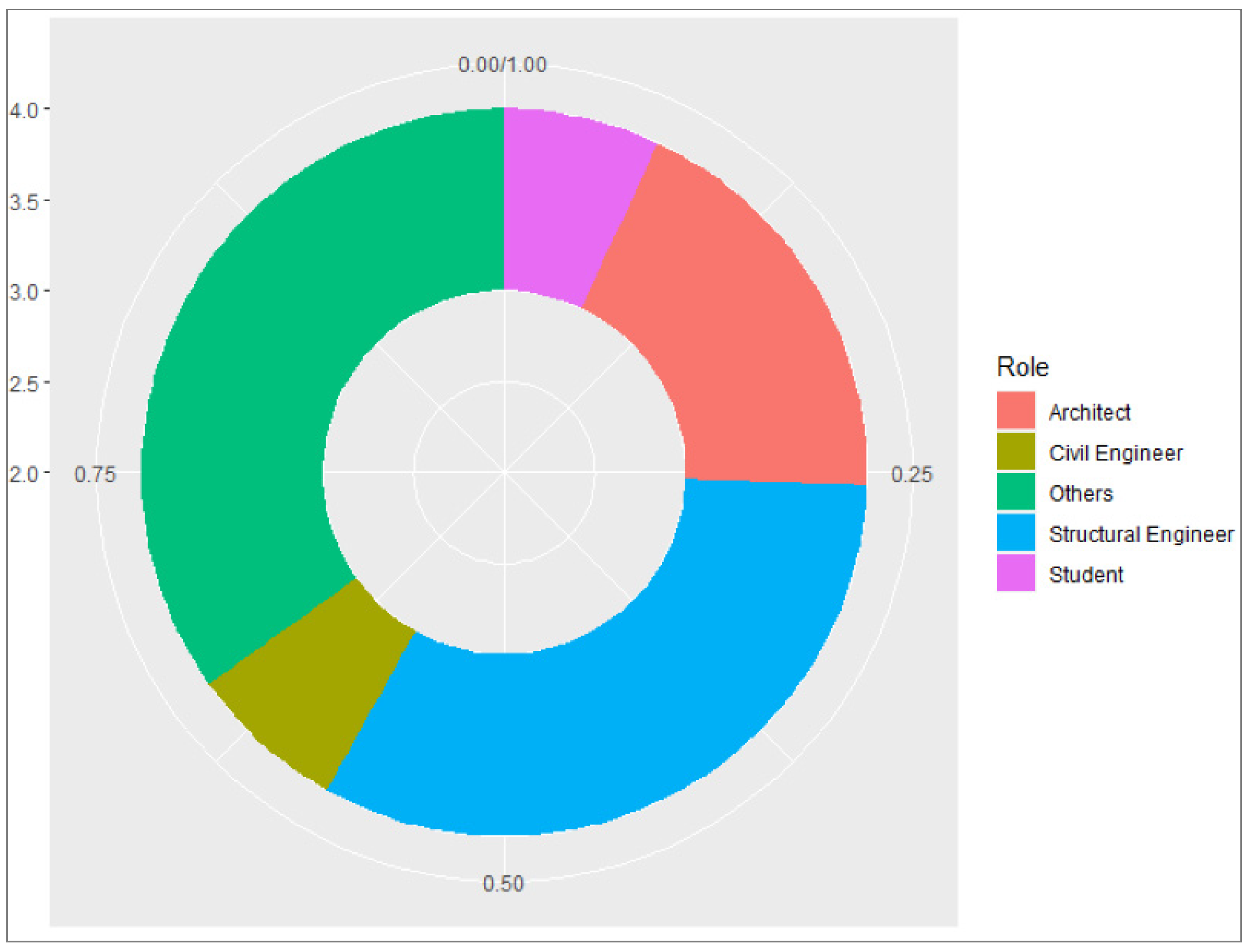
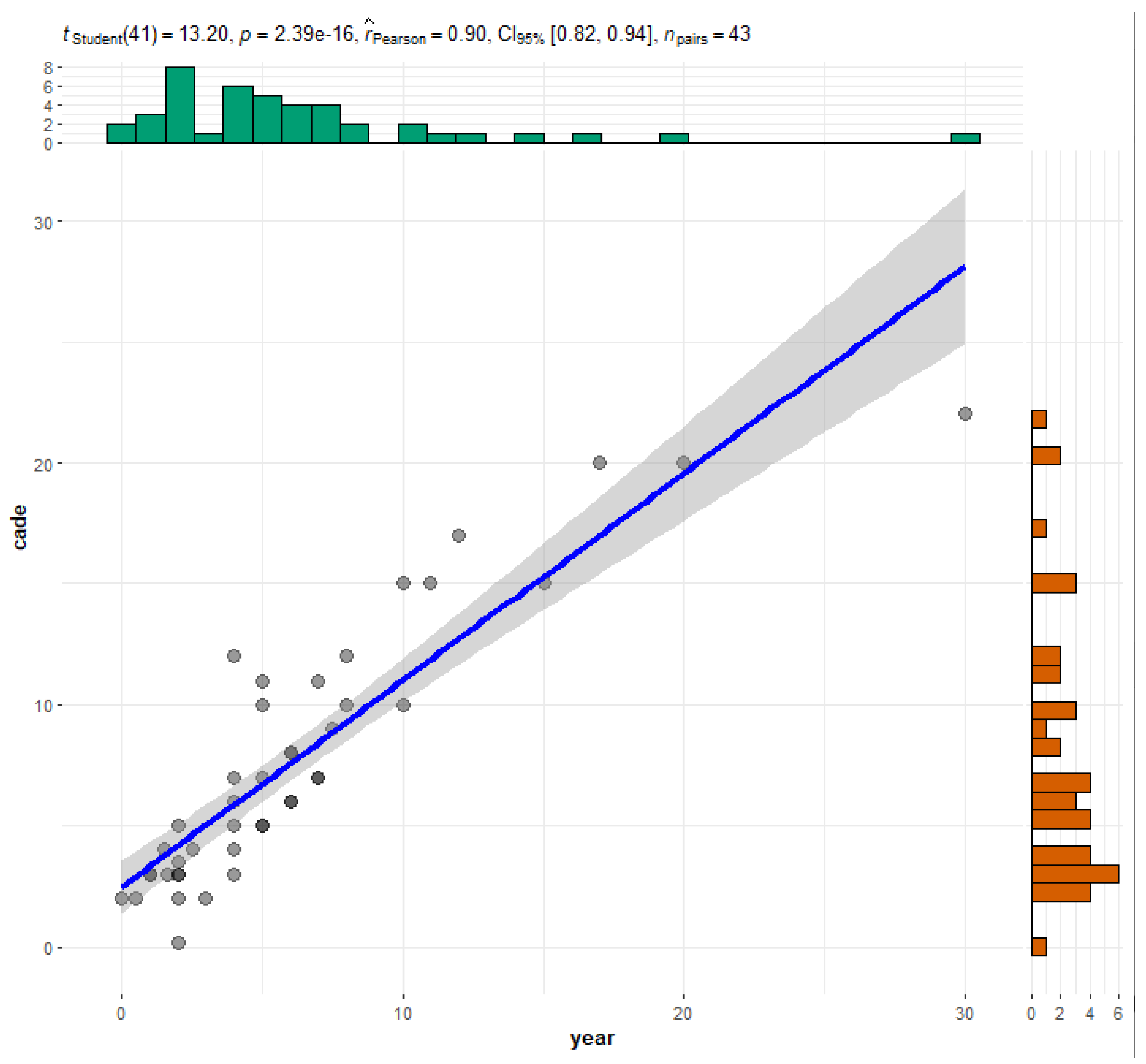
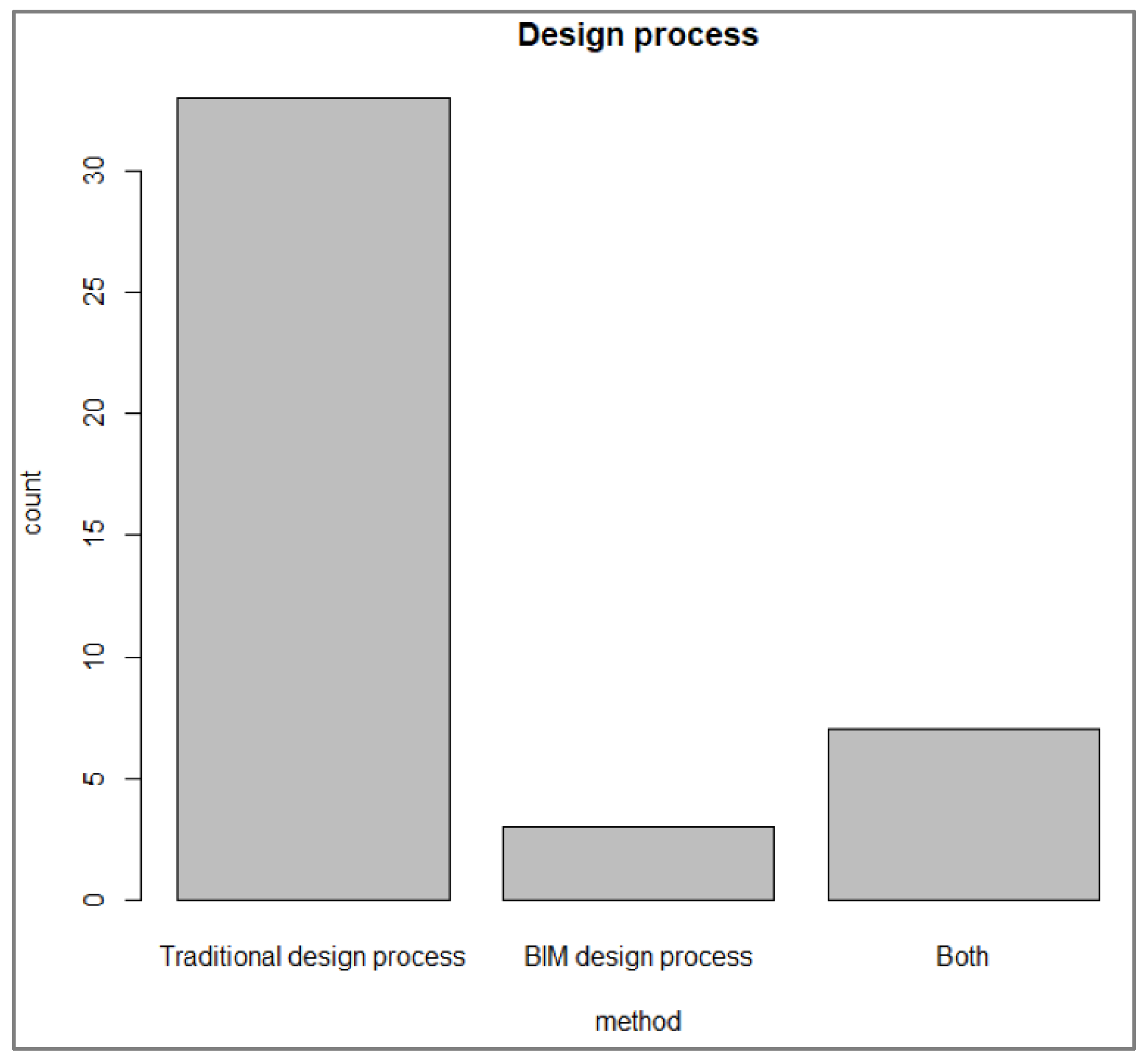
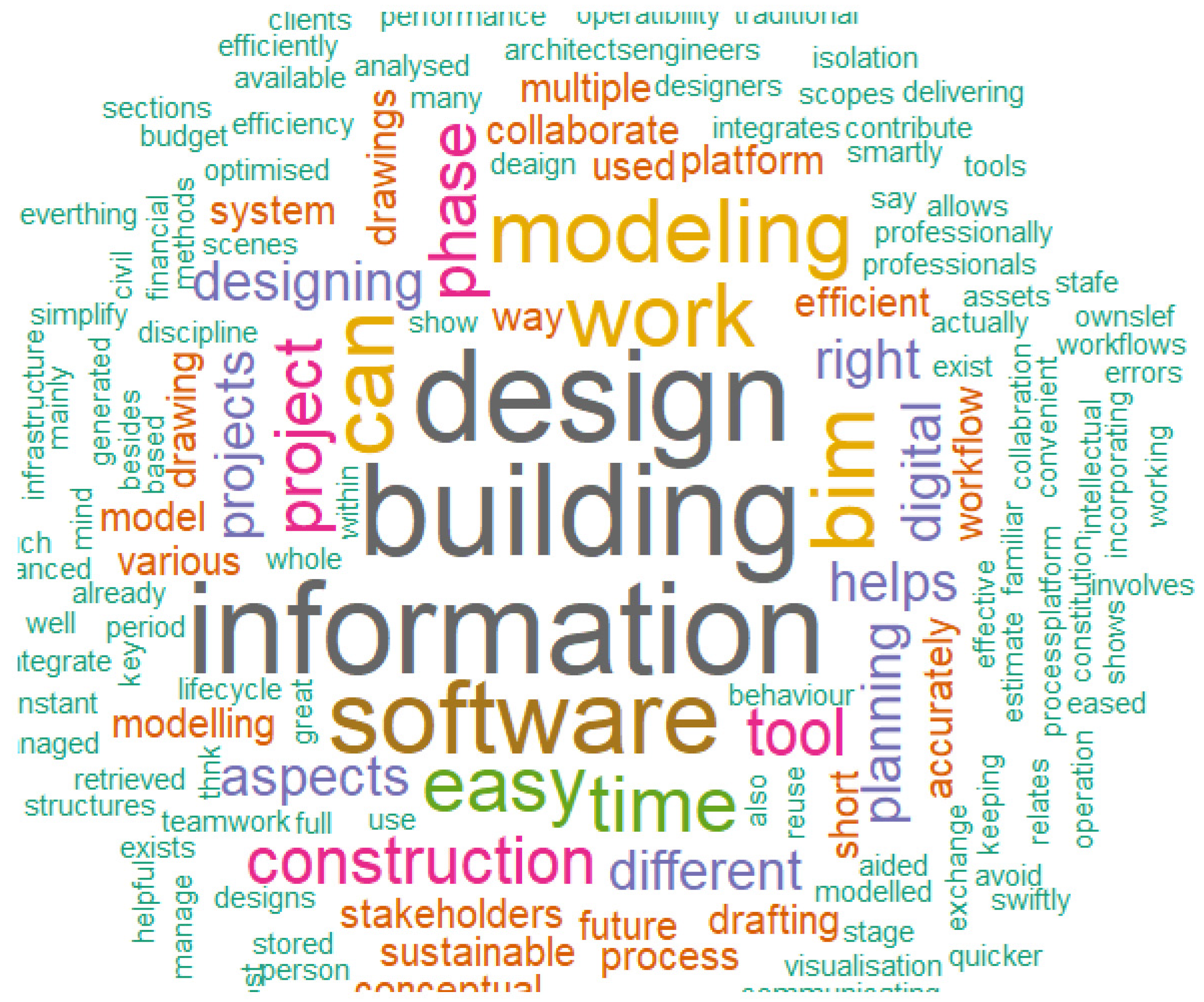
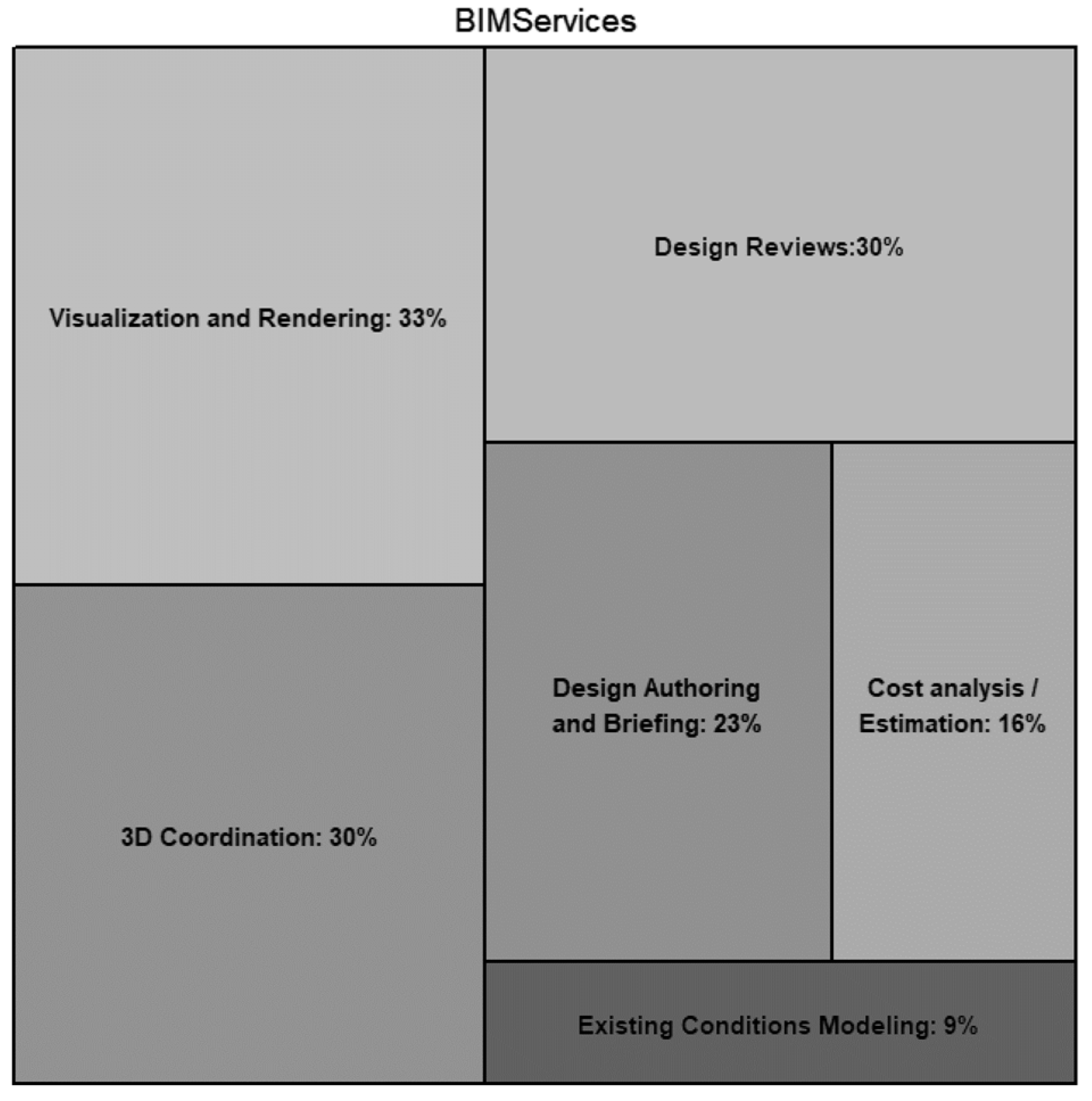
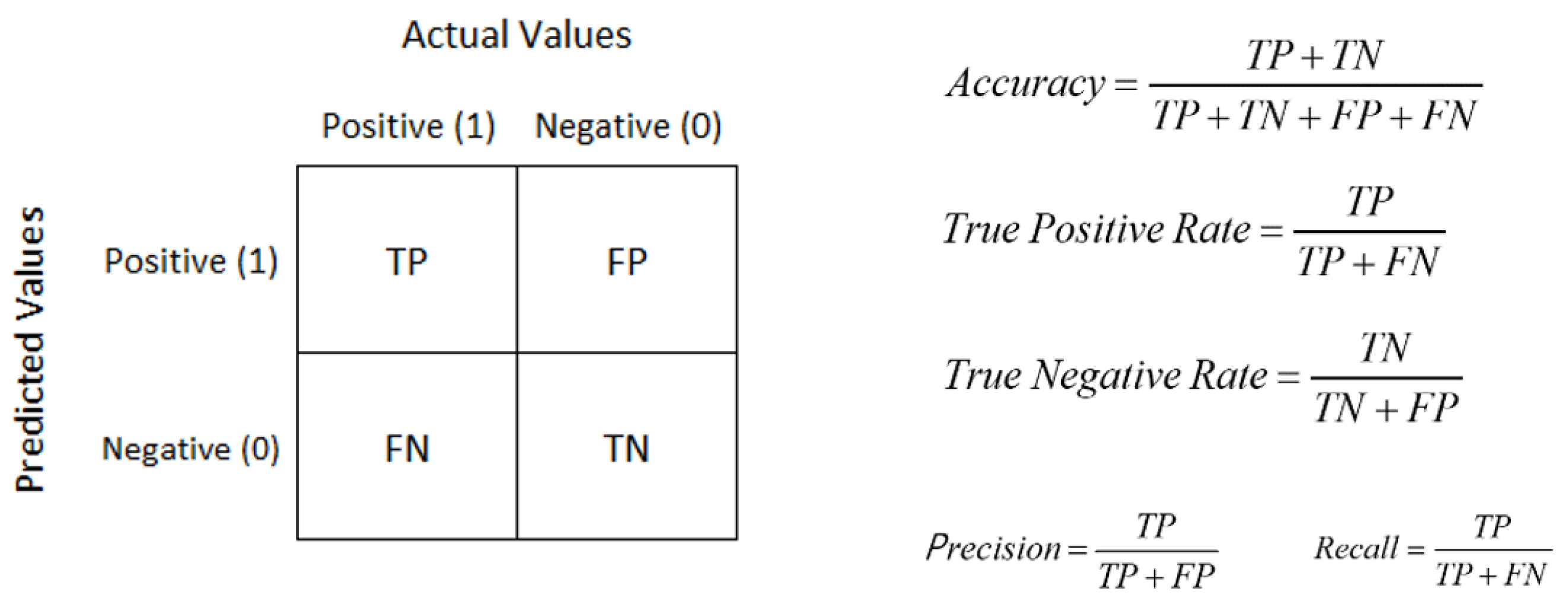

| Country/Region | BIM Standards |
|---|---|
| Singapore | The Building and Construction Authority (BCA) announced that by 2014, plan submissions of all projects with a gross floor area of more than 5000 sq m require BIM. |
| Hong Kong | The Hong Kong Housing Authority established BIM standards in 2014/2015. |
| Canada | The BIM Council was founded in late 2008. |
| U.K. | The Construction Project Information Committee (CPIC) required full BIM implementation by 2016. |
| U.S. | Not a national standard yet, but each agency has its road map for the BIM requirements. |
| New Zealand | New Zealand BIM Handbook, 2014. |
| Subjects= | 17 |
| Kappa= | 0.585 |
| Z= | 6.62 |
| p-value | 3.7 × 10−11 |
| BIM Implementation Barriers | Rank | Response |
|---|---|---|
| Lack of BIM education and knowledge | 1 | 81% |
| Lack of BIM technology experts | 2 | 67% |
| Lack of policy, standards, and mandate from the government | 3 | 66% |
| Low knowledge about the benefits of BIM | 3 | 65% |
| The practicability of BIM implementation is not well understood | 4 | 55% |
| Lack of demand from the client | 5 | 51% |
| Higher software cost | 6 | 50% |
| Cultural barrier/Resistance to change | 7 | 23% |
| Fear of high risk of investment | 8 | 23% |
| Lack of infrastructure (computers and hardware) in the office | 8 | 22% |
| Legal issues (government procurement laws) | 8 | 21% |
Disclaimer/Publisher’s Note: The statements, opinions and data contained in all publications are solely those of the individual author(s) and contributor(s) and not of MDPI and/or the editor(s). MDPI and/or the editor(s) disclaim responsibility for any injury to people or property resulting from any ideas, methods, instructions or products referred to in the content. |
© 2023 by the authors. Licensee MDPI, Basel, Switzerland. This article is an open access article distributed under the terms and conditions of the Creative Commons Attribution (CC BY) license (https://creativecommons.org/licenses/by/4.0/).
Share and Cite
Paneru, S.; Ghimire, P.; Kandel, A.; Thapa, S.; Koirala, N.; Karki, M. An Exploratory Investigation of Implementation of Building Information Modeling in Nepalese Architecture–Engineering–Construction Industry. Buildings 2023, 13, 552. https://doi.org/10.3390/buildings13020552
Paneru S, Ghimire P, Kandel A, Thapa S, Koirala N, Karki M. An Exploratory Investigation of Implementation of Building Information Modeling in Nepalese Architecture–Engineering–Construction Industry. Buildings. 2023; 13(2):552. https://doi.org/10.3390/buildings13020552
Chicago/Turabian StylePaneru, Suman, Prashnna Ghimire, Ayushma Kandel, Sudhir Thapa, Nirmal Koirala, and Mahesh Karki. 2023. "An Exploratory Investigation of Implementation of Building Information Modeling in Nepalese Architecture–Engineering–Construction Industry" Buildings 13, no. 2: 552. https://doi.org/10.3390/buildings13020552
APA StylePaneru, S., Ghimire, P., Kandel, A., Thapa, S., Koirala, N., & Karki, M. (2023). An Exploratory Investigation of Implementation of Building Information Modeling in Nepalese Architecture–Engineering–Construction Industry. Buildings, 13(2), 552. https://doi.org/10.3390/buildings13020552






